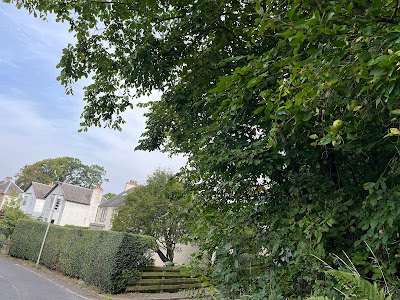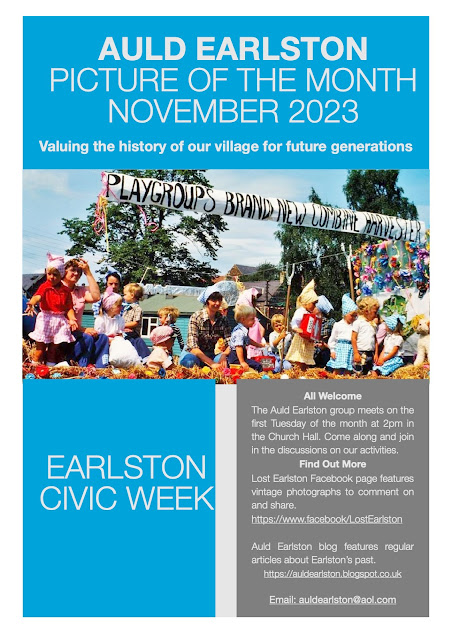Suppose road signs had been compulsory over the centuries. In that case, these names would have appeared instead of Earlston - Earlstoun, Earlstown, Earls Town, Ercildoune, Ersilton and Ercheldun. And just to be inclusive, the perhaps the sign should incorporate the Gaelic for Earlston - Dùn Airchill.
If you grew up in Earlston in the 1950s and 1960s, chances are you called 'the burn' the Trufford burn.
Now it's called the Turfford.
Has the name been changed, or was the wrong name used before?
This newspaper clipping dated 1896 shows that the burn was known as the Trufford. Yet forty years before the newspaper notice, a map of the area shows the name 'Turfford'.
 |
| Credit: Southern Reporter 1896 |
Some old documents claim that Turfford's name came from an area of ground close to the burn that the owner of Cowdenknowes allowed villagers to cut turfs to use as fuel for their fires. This was before the Midlothian coal fields and transport links provided a coal supply. The peat bog was subsequently drained during the construction of the railway.
Streets prefixed 'Thorn' refer to the ancient thorn that grew close to where the Black Bull stands.
'As long as the Thorn Tree stands, Ercildourne shall keep its lands'.This was the first of several prophecies attributed to Thomas the Rhymer collected by Robert Chambers, who identified the tree in question as one that fell in a storm in either 1814 or 1821, presumably on the about the last remaining acre belonging to Earlston. The prophecy was lent additional weight at the time because, as it so happened, the town merchants had fallen under bankruptcy due to a series of "unfortunate circumstances". According to one account, "Rhymer's thorn" was a huge tree growing in the garden of the Black Bull Inn, whose proprietor, named Thin, had its roots cut all around, leaving it vulnerable to the storm that same year.
Some streets have been named after their destination - Church Street, Station Road, Mill Road and Haugh Head Road.
Three streets are named after historical events. Queensway and Crown Crescent mark the succession of Queen Elizabeth II to the throne. And Everest Road commemorates conquering Mount Everest.
A few streets are named after people. Hope Knowe nods to the Hope family that once lived at Cowdenknowes. Roger's Place, William Bank and Jane Field are named after family members of the builders, Rogers. Roosevelt Place refers to Teddy Roosevelt, the 26th president of the USA. The houses were built by stonemason John Mercer and were completed in 1910, the year after Roosevelt left office. The connection to Roosevelt could be more apparent. However, John Mercer's brothers, George, Andrew and James, had emigrated to America. The brothers settled in Hackensack, where George became a successful businessman in Lodi, the postmaster for several years and the mayor. The block of houses may have been named after the former president to acknowledge the Mercer family's fortunes in America.
George Mercer
Credit: Auld Earlston Collection
This was an agreement between Earl of Angus and Alexander Home to purchase twenty pounds worth of land of Ersilton, namely 'the mains of Ersilton with its pertinent, the 'lang akers' for £2, Carelside for £1, the 'Thowlescrouk' for £1 the 'hal orchard' which is called the manor of the same, the mains with Cowdenknowes for £6, the five husbandlands next to and on the east side of the manor for £5 (a husbandland is about 26 acres or 10.5 hectares) Philipston, Fawlo, and Willestroder meadow for £5, all in the lord ship of Earlston and Sheriffdom of Berwick' dated Edinburgh 11 October 1484.
Since a 'combe' is the name given to a wooded valley, Halcombe may be the 'hal orchard' mentioned above. Indeed, a recent visit to the Redpath road showed an excellent crop of apples in the woods just next to Halcombe Crescent!
Like the Turfford burn, the name of the Kidgate has changed over the years. Readers may remember the lane was called 'Kirkgate', but according to the Berwickshire OS Name Book of 1856-1858, Kidgate is the correct name. The book describes the street as 'A narrow lane leading Southward from the South end of New Street consisting of a few thatched Cottages with two or three slated houses and tenanted by Mechanics and labourers.'
New Street is now Thorn Street, and the 'Mechanics' would be tuners from the tweed mill.
And to confuse things, here's an old postcard of 'Kirkgate' showing what appears to be a church (but is, in fact, the 'Manse Hall').
 |
Kidgate showing Manse hall Credit: Auld Earlston Collection |
Can you help?
We have yet to find out where the names come from for three streets: Arnot Place, Kilknowe and Bellevue Terrace. Please let us know where the names are from in the comments below.
.jpeg)


